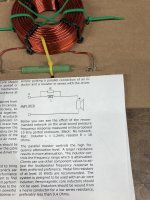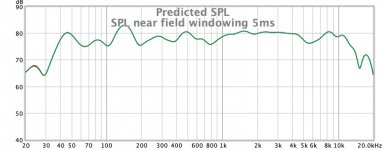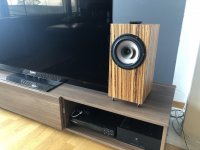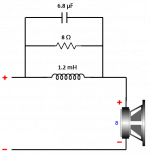Finished a new FEA18RCZ build using the specs provided in the Seas Application Note exactly. Great sound except for the extremely bright top end. Not really listenable at higher volumes. Seas recommends to install an inductor/resistor circuit, and recommends using 1.2mH and 18 Ohms. I had a 15 Ohm, so I used it instead. Now the highs are severely attenuated, and not really listenable. Almost as if you removed the tweeter from a typical 2-way system. Do you think that using a 15 Ohm instead of the 18 Ohm made much of a difference? I wouldn't think so, and if anything it would have attenuated the higher frequencies less than an 18 Ohm resistor. Seas states that this design "offers the listener a loudspeaker system with a precise, coherent and engaging listening experience using this high quality driver." I attached a picture of the assembly I put together for testing. Thanks for the help!
Attachments
Hi,
You can of course play with the values and adjust to taste. Addition of a capacitor (in parallel with the R and the L) will bring the high treble back. Try some values between, let´s say 3,3uF and 6,8uF, and listen. Try cheaper film types first, before you invest in a decent cap.
Or get some measurement equipment, measure and correct the FR accordingly. A correction circuit for a fullrange driver might than in the end be much more complex than the SEAS´ suggestion, which nonetheless is nice for a start.
If you measure, a slight treble rise is nearly always wanted with a FR unit, to counter the directivity of the large cone and to remain a proper room response.
All the best
Mattes
You can of course play with the values and adjust to taste. Addition of a capacitor (in parallel with the R and the L) will bring the high treble back. Try some values between, let´s say 3,3uF and 6,8uF, and listen. Try cheaper film types first, before you invest in a decent cap.
Or get some measurement equipment, measure and correct the FR accordingly. A correction circuit for a fullrange driver might than in the end be much more complex than the SEAS´ suggestion, which nonetheless is nice for a start.
If you measure, a slight treble rise is nearly always wanted with a FR unit, to counter the directivity of the large cone and to remain a proper room response.
All the best
Mattes
It got severe peaks of 15dB arround 6-12kHz, it will need a lot of eq to fix that. Best is to measure and use a sim software with that measured response to tame that. First thought is a broad filter attenuating 3-5dB from 1kHz on, and a few sharp notches to tame those peaks. DSP will be easiest, but it should also be doable passive also, but it will probally be more complex than you wished...
Hi waxx,
That´s right, a passive correction of a FR is doable, but the level of complications is rising fast. And in the end, you´ll find that your results are not challenging any decent 2-way in linearity...
You´ll need a measurement system and either a large box of parts or something like Xsim if you want to go all out. Even then, your ears might very well tell you that you´re overdoing things, less can be more, and certain measured abbrevations from the ideal might sound better.
For jd, a broadband LCR, adjustable be ear, might be the best start. The higher the breakups are in frequency, the less important are they, due to frequency sensitivity of our ears. And then, catching a 15kHz breakup with passive parts is nearly impossible...
All the best
Mattes
That´s right, a passive correction of a FR is doable, but the level of complications is rising fast. And in the end, you´ll find that your results are not challenging any decent 2-way in linearity...
You´ll need a measurement system and either a large box of parts or something like Xsim if you want to go all out. Even then, your ears might very well tell you that you´re overdoing things, less can be more, and certain measured abbrevations from the ideal might sound better.
For jd, a broadband LCR, adjustable be ear, might be the best start. The higher the breakups are in frequency, the less important are they, due to frequency sensitivity of our ears. And then, catching a 15kHz breakup with passive parts is nearly impossible...
All the best
Mattes
if you dont have any of equipment described above.. take a cheap way.. buy 5W resistors, 6.8R, 8.2R, 10R, 15R.. and try to put in parallel with the coil, one at a time and listen..bigger resistance - less top end.. lower resistance - more top end..Finished a new FEA18RCZ build using the specs provided in the Seas Application Note exactly. Great sound except for the extremely bright top end. Not really listenable at higher volumes. Seas recommends to install an inductor/resistor circuit, and recommends using 1.2mH and 18 Ohms. I had a 15 Ohm...,
also new driver is maybe sharp so you need to wait break in period, 100h or so..
1. Run them in
FR speakers need long time to run in, 100 to 300 hrs. Dont speed up that process by run-in discs, extreme bass tracks or very loud playing. Best way is to leave them playing some radio station at normal listening level.
2. Speakers position
Put them close to rear wall or even corner.
That will boost the bass and some low-mids to. But, you need to experiment alot for optimum result, so be patient. Listen for few days, write down your impressions, try another position and so on until you find the best one.
3. Listening position
If you walked around the room when music is playing you noticed that bass volume is changing. So find listening position with more bass, for example closer to rear wall.
4. Of axis listening
Point your speakers directly to your ears, left to left, right to right. Then rotate them in or out by 10 to 15 degrees. That will attenuate highs.
5. Room treatement
If you have naked walls and floor in your room put some absorbent material to tame highs. Especially rear wall, beacuse FR speakers have highs concentrated to narrow beam, so most of HF energy will end up there.
6. Adjust rest of the system
Try with different cables to get more bass and less highs. They dont have to be expensive.
If you have turntable, get cartridge or mat with warmer sound etc.
And check this out: I have cheap Sony CDP-XE220 CD player. When I change the polarity of power plug there is audible change in sound: open and bright in one position, warmer with more bass in other. I heared about that tweak long time ago, but realised it just recently!
Using all that I managed to get good tonal balance with my Seas FA22RCZ speakers, without additional filters.
Good enough even for electronic music, disco, heavy metal or hip-hop. At normal listening levels.
Also, your ears need some time to adopt to new speakers too. Give them a time!
FR speakers need long time to run in, 100 to 300 hrs. Dont speed up that process by run-in discs, extreme bass tracks or very loud playing. Best way is to leave them playing some radio station at normal listening level.
2. Speakers position
Put them close to rear wall or even corner.
That will boost the bass and some low-mids to. But, you need to experiment alot for optimum result, so be patient. Listen for few days, write down your impressions, try another position and so on until you find the best one.
3. Listening position
If you walked around the room when music is playing you noticed that bass volume is changing. So find listening position with more bass, for example closer to rear wall.
4. Of axis listening
Point your speakers directly to your ears, left to left, right to right. Then rotate them in or out by 10 to 15 degrees. That will attenuate highs.
5. Room treatement
If you have naked walls and floor in your room put some absorbent material to tame highs. Especially rear wall, beacuse FR speakers have highs concentrated to narrow beam, so most of HF energy will end up there.
6. Adjust rest of the system
Try with different cables to get more bass and less highs. They dont have to be expensive.
If you have turntable, get cartridge or mat with warmer sound etc.
And check this out: I have cheap Sony CDP-XE220 CD player. When I change the polarity of power plug there is audible change in sound: open and bright in one position, warmer with more bass in other. I heared about that tweak long time ago, but realised it just recently!
Using all that I managed to get good tonal balance with my Seas FA22RCZ speakers, without additional filters.
Good enough even for electronic music, disco, heavy metal or hip-hop. At normal listening levels.
Also, your ears need some time to adopt to new speakers too. Give them a time!
Thank you everyone for the assistance. I paid a good amount for the drivers, and need to make them work. I'm a little disappointed in the Seas published info though, and their claim that it would make a "precise, coherent and engaging listening experience". I will see if I can "correct" (or tailor?) the sound to my taste. This may be a silly question, and I'll show my electronics ignorance here, but do they make a variable resistor I can put in parallel with the inductor, and adjust it on the fly to my preference? Then I would know what value to insert. That would seem easier than swapping resistors. Thanks for the help!

By this there is about a 5dB shelf above 1kHz before it goes chaotic in the top 2 octaves. Cone, whizzer, dustcap, and the “trapped” airspeces they define all play a role in the chaos.
The only things you can do to the driver to help are not reversible. And until someone tries them we don’t know their applicability to this particular driver.
I have done up FA22, but it is much better behaved to start with. And tamed or at least exacerbated the crap that often happens up top in a FR.
Phase plugs?
They often help with laser HF. And losing the dustcap should also help.

Carefully massage the edge of the whizzer, then a couple coats of Zig 2-way glue at the whizzer edge on the backside.
That will work to tame the whizzer itself and the air space its frontside defines.
The 98¢ whizzer trick also helps to control the free whizzer edge and damp the airspace between the back of the whizzer and the cone. Very low density foam (furnace foam or similar), well teased poly fluff, even hair scrunchies have been used.
The Zig glue might also help if applied at the cone surround interface on the back of the cone.
My first goto with any paper cone is a thin coat of slightly thinned ModPodge on the front of the cone and whizzer.
Beyond that one would have to suss out the exact spots on the back of the cone or whizzer to modify the cne response in a useful way.
The 5dB shelf will have to be dealt with some sort of filter. If you can get the box narrow enuff to add the baffle step at the same frequency as any BSC — unlikely. The driver would be wider than the baffle. The same kind of filter works. Parallel RC in series with the FR to drop excess above 1Khz.
Did you say what kind of amp you are driving these with?
You could also try a box with an upward firing driver?
dave
i had the same disappointment with alpair 12p, which is unlistenable -without the filter .. you throw a lot of the money for the school that total full range concept does not exist.. for me the best sounding FR without the filter is Fostex FE103.. beautiful and magical driver in the horn... but is only 5W..Thank you everyone for the assistance. I paid a good amount for the drivers, and need to make them work. I'm a little disappointed in the Seas published info though, and their claim that it would make a "precise, coherent and engaging listening experience". I will see if I can "correct" (or tailor?) the sound to my taste. This may be a silly question, and I'll show my electronics ignorance here, but do they make a variable resistor I can put in parallel with the inductor, and adjust it on the fly to my preference? Then I would know what value to insert. That would seem easier than swapping resistors. Thanks for the help!
so here you need to make correction with the L/R filters to work for you..you can buy 4-5W rheostat (variable resistor) 15-20 ohms
I'll show my electronics ignorance
I'll show mine in that I was taught to use an R/C or RLC network [CD horn EQ] if very wide band EQ was required, so had done/recommended using a cheap 25 ohm pot to flatten the response as much as practical, then replace the pot with a resistor [grid] of high quality resistors and choose a by-pass cap [PIO preferred] to 'let through' the extreme highs to 'taste'.
In short, could/did sometimes use a high quality $pot$, but never felt the need to use an inductor to tame 'shouting' speakers.
Hi-I used the 6,5" Seas driver in a project two years ago.
Now, I did build it as a sealed enclosure, I just like them better, and I use a MiniDSP to linearize the higher frequency area. In short, the speaker is very good, it makes my Alpair 7.3 bassreflex build sound like a toy.
I think, however, that the speaker is quite well suited for DSP adjustment. I have attached the adjustment file (graph) and a nearfield windowed measurement, not smoothed.
Now, I did build it as a sealed enclosure, I just like them better, and I use a MiniDSP to linearize the higher frequency area. In short, the speaker is very good, it makes my Alpair 7.3 bassreflex build sound like a toy.
I think, however, that the speaker is quite well suited for DSP adjustment. I have attached the adjustment file (graph) and a nearfield windowed measurement, not smoothed.
Attachments
Seas recommends to install an inductor/resistor circuit, and recommends using 1.2mH and 18 Ohms. I had a 15 Ohm, so I used it instead. Now the highs are severely attenuated, and not really listenable. Almost as if you removed the tweeter from a typical 2-way system. Do you think that using a 15 Ohm instead of the 18 Ohm made much of a difference? I wouldn't think so, and if anything it would have attenuated the higher frequencies less than an 18 Ohm resistor.
You're right. You can parallel 15 ohm resistors with each other to make a 7.5 ohm and try that, if you have more. The bsc calculated always has to be modified in the resistor by ear, even a couple tenths of an ohm seem to make a difference. Not sure what seas' selecton methodology is, but keep iterating different resistors until it's the best you can get it, like bepone suggested.
Oh, and it's good news you rolled off all the highs. It means there's a happy medium in there somewhere, so don't be discouraged! 🙂
The loudspeaker measures better at home than the graphs produced by Seas suggests. So please don´t be discouraged, it will be good. I suggest using REW so you know the effect of your adjustments:
- Measure at different distances 50 cm, 1m, 3m etc.
- Use windowing function
This will help to understand the "bigger picture", what are diffraction issues (not adjustable), and what are driver deviations (you can adjust them). As you can see from the picture, I use the loudspeakers in a setup with my TV, which extends the baffle. This reduces baffle step issues, and results in a "fuller" sound.
- Measure at different distances 50 cm, 1m, 3m etc.
- Use windowing function
This will help to understand the "bigger picture", what are diffraction issues (not adjustable), and what are driver deviations (you can adjust them). As you can see from the picture, I use the loudspeakers in a setup with my TV, which extends the baffle. This reduces baffle step issues, and results in a "fuller" sound.
Attachments
Thank you all for the help. Through trial and error (using my ears) to find a suitable sound I like, I ended up with a 4 ohm resistor in parallel with the 1.2mH inductor. Much more efficient than my P17/D25 build from a few years back, and a bit different "sound". I would like a bit more highs above 10K without boosting the range between 5-10K though. Would adding a capacitor in parallel with the network I have take care of this? More trial and error is required I'm guessing, which is ok. Thanks again!
Thank you all for the help. Through trial and error (using my ears) to find a suitable sound I like, I ended up with a 4 ohm resistor in parallel with the 1.2mH inductor. Much more efficient than my P17/D25 build from a few years back, and a bit different "sound". I would like a bit more highs above 10K without boosting the range between 5-10K though. Would adding a capacitor in parallel with the network I have take care of this? More trial and error is required I'm guessing, which is ok. Thanks again!
Hi,
Exactly. As per my first message.
Best regards
Mattes
SEAS FEA18RCZ Build Update - Success
Thank you all again for the help, I couldn't have done it without your input. I kept at it, and after even more trial and error, I settled on a network of 1.2 mH inductor, 8 ohm resistor, and 6.8 uF capacitor. I know everyone has individual tastes, but for me this sounds great, and I would encourage anyone to try it. Thanks again. Now I can finish the cabinets and enjoy!
Thank you all again for the help, I couldn't have done it without your input. I kept at it, and after even more trial and error, I settled on a network of 1.2 mH inductor, 8 ohm resistor, and 6.8 uF capacitor. I know everyone has individual tastes, but for me this sounds great, and I would encourage anyone to try it. Thanks again. Now I can finish the cabinets and enjoy!
Attachments
Hi,
Great if it sounds great!!!
And yes, that´s exactly how in my opinion wideband drivers should be used, with a sensible correction. If you choose high-quality components, there´s no reason to be afraid of passive components in your speakers.
Depending on your needs, the LCR correction can be finetuned with parallel notches, but that would require measurements and more experimentation.
If you´re happy with the sound, buy records and have fun!
All the best
Mattes
Great if it sounds great!!!
And yes, that´s exactly how in my opinion wideband drivers should be used, with a sensible correction. If you choose high-quality components, there´s no reason to be afraid of passive components in your speakers.
Depending on your needs, the LCR correction can be finetuned with parallel notches, but that would require measurements and more experimentation.
If you´re happy with the sound, buy records and have fun!
All the best
Mattes
- Home
- Loudspeakers
- Full Range
- Seas FEA18RCZ - Finished but higher frequencoes too bright!




